Economic and Political Weekly April 7, 2007
SUMANTA BANERJEE
Once a political movement becomes
an object of public hatred and
derision, it presages the erosion of
its base and forecasts the eclipse of its
credibility. Sad to say, the Left movement
in West Bengal is hanging under such a
threat. We should not in the least undermine
the serious challenge faced by the
Left Front government there which stands
on the threshold of a new direction of
growth and faces choices of models to be
adopted. But whatever choice it makes has
to be embedded in probity and integrity.
And it is in this respect that the Left has
failed us. Nandigram is an example of one
more betrayal on the top of the already high
pile of disappointments.
The debate over the popular agitation
and the state response in Nandigram has
till now been confined mainly to three
issues: (i) the conflict between the economic
priorities of agricultural production
and industrial growth; (ii) the way the state
should handle it; and (iii) its human rights
dimension. Notwithstanding the importance
of debating these questions, it is
urgent to foreground the more basic
concern – the decline in moral standards
in Left politics over the last two to three
decades which has eaten into the marrows
of the Left movement and dragged it into
the present quagmire.
When in 1977 the West Bengal electorate
voted the Left Front to power with a
thumping majority, they did not bargain
for a communist revolution, but expected
a clean and efficient administration that
would carry out long awaited land reforms
and meet the basic needs of the urban
populace. Endowed with a legacy of
struggle against exploitation and an image
of sacrifice and honesty, the communists
of West Bengal were supposed to set their
government as a role model for other states.
Today, after 30 years of continuous rule, the
Left leaders of the state face the problem
of re-establishing their credibility not only
among their own constituency, but also in
the entire country. The initial euphoria over
the success of land reforms, the panchayati
system and adult literacy programmes, soon
gave way to scepticism when skeletons
started tumbling out of the cupboard.
At the turn of the 21st century, it was
revealed that only15 per cent of the net
arable land had been distributed in the
state. Even among those who received
land, on an average 13 per cent had lost
it by 2001, and the number of landless rural
households increased from 39.6 per cent
in 1987-88 to 49.8 per cent in 2000 (according
to the West Bengal government’s
first Human Development Report). The
Human Development Report of the Planning
Commission brought to light far more
devastating facts – in rural West Bengal
85 per cent of the population did not have
pucca houses; women and children were
more underfed and anaemic than in other
states; 35.66 per cent of its population still
remained below the poverty line – all these
figures reducing the state to the 20th
position in the list of 32 states and union
territories in terms of the human development
index. The government’s tall claim
of improving the lot of dalits and tribal
people was also punctured soon when the
Pratichi Trust, headed by no less a person
than Amartya Sen, came out in 2002 with
shocking revelations about the discrimination
against students of scheduled castes
and tribes in the primary schools of the
state. As for the other Left proclamation of
enhancing the status of the Muslim minority
(which constitutes almost a quarter of
the population of the state), the Sachar
Committee found that its share in state jobs
was only 4.2 per cent. We must add to this
the dismal record of the government’s
failure to prevent closure of factory after
factory, leading to unemployment and
suicide among industrial workers.
One can, of course, endlessly go on
arguing over the causes – whether it was
the centre’s “step-motherly” treatment in
allocating financial resources, whether it
was the Left leadership’s failure to plan a
long-term strategy of follow-up measures
to bring about sustainable development, or
whether it was the built-in structural hurdle
in the capitalist system within which the
Left had to operate. But curiously enough,
despite all these failures, the overwhelming
presence of the Left is all-pervasive
in West Bengal, as evident from its ability
to emerge victorious with the same thumping
majority in every consecutive election
over the last three decades.
Expanding Base,
Shrinking Ideological Roots
Paradoxical as it might sound, it is this
victory at the polls – “the never ending
audacity of elected persons”, as once
described by Walt Whitman – that pulled
the Left down to the depths of abominable
Moral Betrayal of a
Leftist Dream
A sense of public anger in West Bengal over Singur and Nandigram
has not added up yet to a statewide agitation against the Left Front.
The electorate is wise enough to recognise that there is no viable
alternative as yet. But if the CPI(M) continues to be obdurate,
public outrage may take desperate forms. Reactionary forces like
the Trinamool and BJP are waiting in the wings – the first such
ominous signs were evident in Singur and Nandigram.
Economic and Political Weekly April 7, 2007 1241
deceit and criminality that were witnessed
in Singur and Nandigram. At face value,
the Left – primarily the CPI(M) – had
expanded its base in West Bengal. But it
had been at the expense of ideological
principles. The fibre of morality in the Left
muscle has withered, and politics in West
Bengal has been reduced to an arena for
partisan manipulation.
The rot started with the CPI(M)’s using
the administration to spread and consolidate
its party base by selectively distributing
largesse, and forcibly doling out
plots of land to sections of the farmers and
peasantry, who ultimately became their
apparatchiki and retainers. This privileged
segment of the rural population has emerged
as a tyrannical force in the West Bengal
countryside – bullying the villagers into
accepting their party dictates, persecuting
those who refuse to toe their line, extorting
money in the name of collecting party
funds, and assuming the role of the sole
arbiter in any village dispute. In several
cases, the landless followers of the party
were settled on plots without any legal
sanction, as a result of which the beneficiaries
did not have any valid papers of
ownership. Sharecroppers working on the
lands of the CPI(M) farmers, instead of
being registered, were promised fringe
benefits in lieu of their due share of crops.
Today, the disastrous consequences of such
short-sighted and irresponsible measures
are evident in Singur and Nandigram, where
these villagers, without any legal documents
to claim compensation for their plots,
which are about to be taken away for industrial
purposes, are refusing to part with
their land and rebelling against the same
party which had once helped them. Their
limits of patience broken, the long intimidated
villagers – both the deprived and the
erstwhile beneficiaries – have come together
to retaliate against the CPI(M). They
are paying back the party in the same coin
by driving out its cadres, burning their
houses, and bludgeoning those who refuse
to join them. Reports of atrocities suffered
by CPI(M) cadres and of those by its
opponents are being believed or disbelieved
solely on the grounds of political predilection.
But while our hearts go out to the poor
CPI(M) followers who have been killed or
driven out from their villages by their
opponents, we must ruefully admit that the
CPI(M) has to blame itself for meeting this
sticky end. By its intimidating method of
establishing party hegemony in the past,
it created the insurmountable dissensions
that are splitting the rural masses today.
It is the same unscrupulous method of
establishing party hegemony that has
corrupted to the marrow the entire administration
and every institution of West
Bengal today. Subservience to the local
party apparatchiki (which includes regular
payment of a fixed amount, described under
the euphemism of “contribution”) is the
criterion for the appointment of teachers
in schools, obtaining a bed in hospital for
treatment, or gaining access to facilities
that should be available to every citizen
in the normal course. The Left Front government
has thus racked up a record of corruption
and official lies in day-to-day governance,
arrant duplicity and muscle power
in politics, and crass partisanship in the
distribution of benefits – a register which
is only second after the score achieved by
Congress, BJP, Samajwadi Party or other
ruling parties. It is increasingly being felt
in public perception that the Left is no
different from these parties, when it comes
to running the administration.
Loss of Moral Philosophy
While shelving the ultimate goal of building
a socialist society, in its bid for immediate
political gains in the competitive electoral
race, the CPI(M) in West Bengal has
abandoned the moral principles that once
underpinned the philosophy of communism.
Establishment of party paramountcy
through rapid aggressive expansionism has
become the substitute for patient ideological
training of its cadres and followers.
The present malaise can be traced to two
predispositions in the Left movement. In
general, the building of the Communist
organisation has been traditionally based
on the Leninist concept of vanguardism –
the discontented and exploited class supplying
the energy and manpower, and the
intellectual vanguard providing the leadership
for the revolution. In West Bengal,
because of the low ideological level of the
present generation of its leaders and ministers,
its vanguardism took an uncouth
form. They simplified Marxism into a
militarist drill of sorts, riding roughshod
over political opposition and cultural dissent.
It gave them the gratifying sense of
superiority and fanatical self-confidence,
without making them realise that a time
would come when the classes that they led
could become organised and autonomous
enough to resist the dictates of the vanguard
(which has happened in Singur and
Nandigram). The second proclivity is
rooted in the birth of the CPI(M) in 1964.
It was born as a rather belligerent child
with a persecution complex – its leaders
being put behind bars soon after its formation,
its cadres hounded by the state,
and forced to operate in secrecy for a long
time. As a result, after coming to power
in the 1967 and again in the1969 state
assembly elections, the party began to put
all its might in spreading its base and
devising self-protective mechanisms,
which often led to turf-wars with smaller
Left parties (e g, the Communist Party of
India, Forward Bloc, and the Revolutionary
Socialist Party). Further, the Naxalbari
uprising posed not only an ideological
challenge, but drew away from it a large
number of its younger cadres and followers.
Incapable of self-introspection and
self-correction – given their inferior intellectual
calibre – the party leaders resorted
to physical violence to eliminate the
Naxalite threat. The most shameful incident
took place on August 12, 1971 in
Baranagar, near Calcutta, when CPI(M)
cadres joined the police in hunting out and
slaughtering more than 100 young Naxalite
workers and sympathisers.
Although stained by such violent acts of
muscle power and overbearing arrogance,
that past record of the CPI(M) had paled
into insignificance by 1977, in comparison
with the more brutal atrocities that the
people of West Bengal had to suffer under
the Congress during the 1975-76 Emergency.
So, when in the 1977 assembly
elections, the people voted back the CPI(M)
to power, they expected it to be more
chastened and develop into a more responsible
party. Alas, after the initial period of
success and sobriety, the party relapsed
into its old mental groove and mode of
functioning! The germs of intolerance,
insecurity and pugnacity with which it was
contaminated at its birth, turned into a fullblown
aneurysm.
Need for an Alternative Left
A few words of caution need to be
added. All this sense of public revulsion
does not add up yet to a statewide agitation
against the Left Front government in West
Bengal. Most of the incidents that have
outraged us are violent examples of local
zealotry – both of the CPI(M) and
Trinamool variety. There is no general
reversal of support against the Left government,
and no wind of a change in favour
of the Congress, Trinamool – and least of
all, the Bharatiya Janata Party – which are
trying to fish in the troubled waters. The
1242 Economic and Political Weekly April 7, 2007
electorate is wise enough to recognise that
in the absence of any viable alternative that
is committed to affirmative action in favour
of the poor, the Left Front still remains the
best bet. But if things are allowed to drift
and the CPI(M) continues to be obdurate
in its overlordship and pigheadedness,
public outrage may explode and take
desperate forms. Right reactionary forces
like the Trinamool and BJP are waiting in
the wings to take over the leadership of
such agitations. The first such ominous
signs were evident in Singur and
Nandigram.
Strangely enough, instead of striking an
independent path and giving an alternative
Leftist orientation to the movements in
Singur and Nandigram, the ragbag of
various Naxalite groups in West Bengal
have joined the Trinamool-BJP cabal – in
a bid to extend their political base in the
state. The disgusting sight of Naxalite
leaders cuddling up to Rajnath Singh of
the BJP in the same dais during the recent
anti-CPI(M) agitations, suggests that they
have adopted the same blinkers of political
opportunism that blur ideological vision,
as had happened in the case of the CPI(M).
Both the CPI(M) and the Naxalites have
debauched the dream of the Left.
West Bengal is in need of an opposition
to challenge the hegemony of a partisan
and oppressive CPI(M) governance. But
it cannot be left in the hands of the
Trinamool-BJP combine – which is more
dangerous given its potentialities of creating
total anarchy and communal mayhem
in West Bengal. The Congress Party
in the state is in a shambles. The alternative
therefore has to emerge from within a new
democratic Left, with constituents that are
seriously committed to the ideology of
socialism and courageous enough to restore
the moral integrity and high principles
of the movement. The time has come
for all Leftist intellectuals in West Bengal
to listen to the still small voice within
them, the inner voice of the ethical self,
and address the question that was raised
many years ago by Langston Hughes, the
famous black poet of the US:
What happens to a dream deferred?
Does it dry up like a raisin in the sun?
Or fester like a sore –
And then run?
Does it stink like rotten meat?
…… …..
May be it just sags like a heavy load.
Or does it explode?
Email: sumbiz@sancharnet.in
EPW
सीपीएम की क्रांति
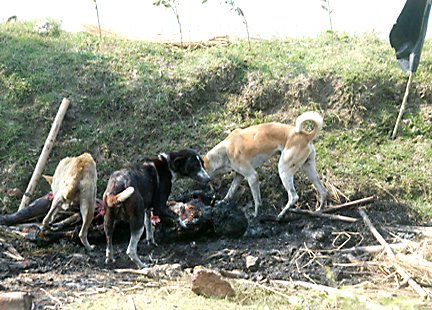
हम एक लोकतंत्र में रह रहे हैं! 14 मार्च को हुई घटना और उसके बाद सीपीएम के बंद के दौरान गायब हुए दो सौ लोगों का अब तक कोई अता-पता नहीं है्. हां। कुछ लाशें हैं जो इलाके में इस हालत में पायी गयी हैं. क्या हम बता सकते हैं कि इन्होंने किस बात की कीमत चुकायी? क्या हम इसको लेकर आश्वस्त रह सकते हं कि हमें भी कभी ऐसी ही कीमत नहीं चुकानी पड़ेगी?
Wednesday, April 25, 2007
Subscribe to:
Post Comments (Atom)
नंदीग्राम पर नयी फ़िल्म
यह फ़िल्म 14 मार्च की घटनाओं के सूक्ष्म विवरण के साथ आयी है.
देखें : नव उदारवाद का नया चेहरा बजरिये नंदीग्राम
देखें : विकास के नाम पर लोगों के उजड़ने की कहानी
उन्होंने मेरे पिता को टुकडों में काट डाला
देखें : न हन्यते
नंदीग्राम में 100 से ज्यादा लोग मारे गये हैं, 200 अब भी लापता हैं. वहां महिलाओं के साथ सीपीएम के कैडरों ने बलात्कार किया. बच्चों तक को नहीं छोड़ा गया है. सीपीएम की इस क्रूरता और निर्लज्जता का विरोध होना चाहिए. हमें नंदीग्राम, सिंगूर और हर उस जगह के किसानों के आंदोलन का समर्थन करना चाहिए, जो अपनी जमीन बचाने के लिए लड़ाई लड़ रहे हैं. यह दस्तावेज़ी फ़िल्म किसानों के इसी संघर्ष के बारे में है. यह फ़िल्म नंदीग्राम के ताज़ा नरसंहार से पहले बनायी गयी थी.
नंदीग्राम में जनसंहार के बाद के द्श्य
यह फिल्म पुलिस द्वारा नंदीग्राम में बर्बर तरीके से की गयी हत्याओं एवं उनकी भयावहता व बर्बरता के बारे में है. इसके कई दृ़श्य विचलित कर देनेवाले हैं.
नंदीग्राम प्रतिरोध्
नंदीग्राम में सरकारी आतंक
देखें : माकपा की गुंडागर्दी
नंदीग्राम में सीपीएम सरकार की पुलिस ने जो बर्बर कार्रवाई की, वह अब खुल कर सामने आने लगी है. यह फ़िल्म उसी बर्बरता के बारे में है. इसके कई दृश्य आपको विचलित कर सकते हैं. आप इसे तभी देखें जब आप वीभत्स दृश्य देख सकने की क्षमता रखते हों. हम खुद शर्मिंदा हैं कि हमें ऐसे दृश्य आपको दिखाने पड़ रहे हैं, पर ये आज की हकीकत हैं. इनसे कैसे मुंह मोडा़ जा सकता है?
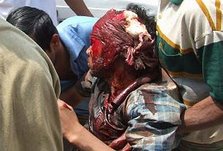
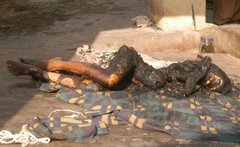
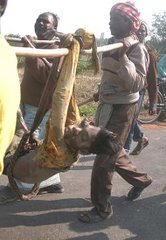
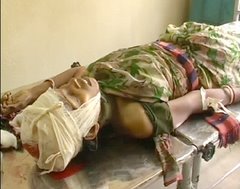

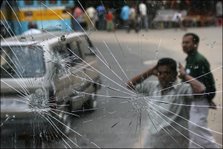
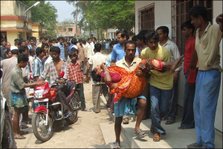

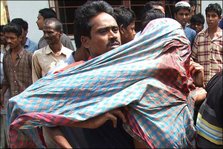


No comments:
Post a Comment